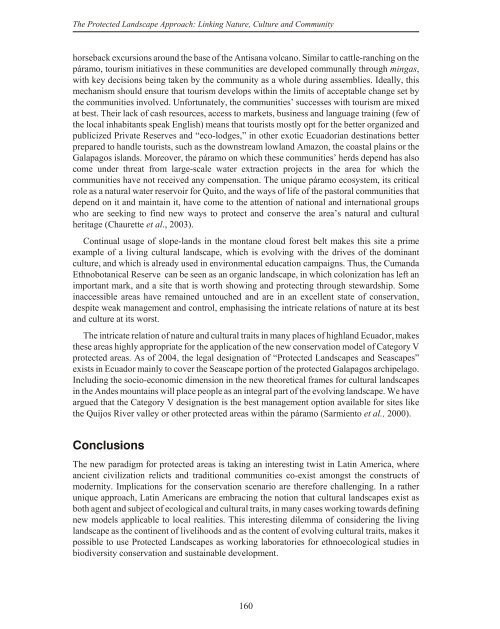The Protected Landscape Approach - Centre for Mediterranean ...
The Protected Landscape Approach - Centre for Mediterranean ...
The Protected Landscape Approach - Centre for Mediterranean ...
You also want an ePaper? Increase the reach of your titles
YUMPU automatically turns print PDFs into web optimized ePapers that Google loves.
<strong>The</strong> <strong>Protected</strong> <strong>Landscape</strong> <strong>Approach</strong>: Linking Nature, Culture and Community<br />
horseback excursions around the base of the Antisana volcano. Similar to cattle-ranching on the<br />
páramo, tourism initiatives in these communities are developed communally through mingas,<br />
with key decisions being taken by the community as a whole during assemblies. Ideally, this<br />
mechanism should ensure that tourism develops within the limits of acceptable change set by<br />
the communities involved. Un<strong>for</strong>tunately, the communities’ successes with tourism are mixed<br />
at best. <strong>The</strong>ir lack of cash resources, access to markets, business and language training (few of<br />
the local inhabitants speak English) means that tourists mostly opt <strong>for</strong> the better organized and<br />
publicized Private Reserves and “eco-lodges,” in other exotic Ecuadorian destinations better<br />
prepared to handle tourists, such as the downstream lowland Amazon, the coastal plains or the<br />
Galapagos islands. Moreover, the páramo on which these communities’ herds depend has also<br />
come under threat from large-scale water extraction projects in the area <strong>for</strong> which the<br />
communities have not received any compensation. <strong>The</strong> unique páramo ecosystem, its critical<br />
role as a natural water reservoir <strong>for</strong> Quito, and the ways of life of the pastoral communities that<br />
depend on it and maintain it, have come to the attention of national and international groups<br />
who are seeking to find new ways to protect and conserve the area’s natural and cultural<br />
heritage (Chaurette et al., 2003).<br />
Continual usage of slope-lands in the montane cloud <strong>for</strong>est belt makes this site a prime<br />
example of a living cultural landscape, which is evolving with the drives of the dominant<br />
culture, and which is already used in environmental education campaigns. Thus, the Cumanda<br />
Ethnobotanical Reserve can be seen as an organic landscape, in which colonization has left an<br />
important mark, and a site that is worth showing and protecting through stewardship. Some<br />
inaccessible areas have remained untouched and are in an excellent state of conservation,<br />
despite weak management and control, emphasising the intricate relations of nature at its best<br />
and culture at its worst.<br />
<strong>The</strong> intricate relation of nature and cultural traits in many places of highland Ecuador, makes<br />
these areas highly appropriate <strong>for</strong> the application of the new conservation model of Category V<br />
protected areas. As of 2004, the legal designation of “<strong>Protected</strong> <strong>Landscape</strong>s and Seascapes”<br />
exists in Ecuador mainly to cover the Seascape portion of the protected Galapagos archipelago.<br />
Including the socio-economic dimension in the new theoretical frames <strong>for</strong> cultural landscapes<br />
in the Andes mountains will place people as an integral part of the evolving landscape. We have<br />
argued that the Category V designation is the best management option available <strong>for</strong> sites like<br />
the Quijos River valley or other protected areas within the páramo (Sarmiento et al., 2000).<br />
Conclusions<br />
<strong>The</strong> new paradigm <strong>for</strong> protected areas is taking an interesting twist in Latin America, where<br />
ancient civilization relicts and traditional communities co-exist amongst the constructs of<br />
modernity. Implications <strong>for</strong> the conservation scenario are there<strong>for</strong>e challenging. In a rather<br />
unique approach, Latin Americans are embracing the notion that cultural landscapes exist as<br />
both agent and subject of ecological and cultural traits, in many cases working towards defining<br />
new models applicable to local realities. This interesting dilemma of considering the living<br />
landscape as the continent of livelihoods and as the content of evolving cultural traits, makes it<br />
possible to use <strong>Protected</strong> <strong>Landscape</strong>s as working laboratories <strong>for</strong> ethnoecological studies in<br />
biodiversity conservation and sustainable development.<br />
160

















